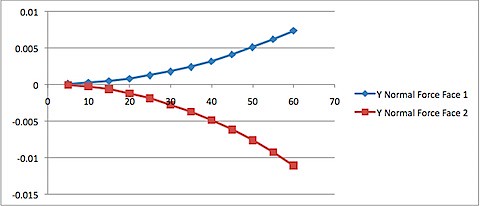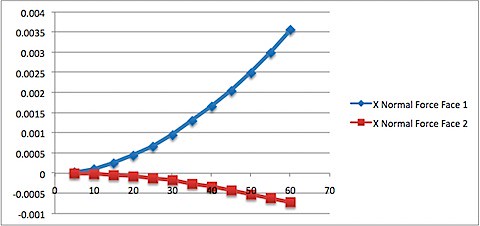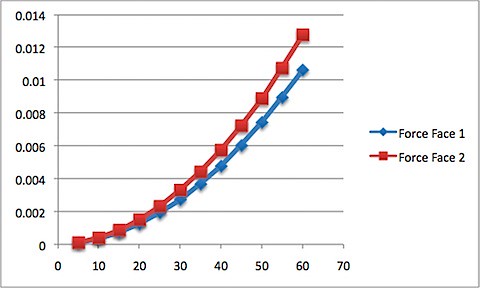I spent the week futzing with running simulations of my simulated beveled biface through a "virtual wind tunnel" with wind velocities parallel to the long axis that varied from 5 meters/second to 60 meters/second. These speeds effectively encompass the range velocities of thrown spears, atlatl darts and bow strung arrows. These simulations used SolidWorks' FloWorks module. I have previously posted some of the graphics of what these simulations look like. In this case, I did a batch run where I changed the velocity from 5-60 m/s in 5 m/s increments. What I am looking for is predicted values that we can use to compare with our actual wind tunnel results. Ideally, I want to be able to measure the amount of force placed on the bevels that result in predicted spin. Here is what I got as a result of all of these runs. The values on the y-axis reflect the amount of force (N) normal to the bevel planes in the y-axis direction of the simulation (i.e., up-down).

Clearly one can see (as would be expected) that the amount of force normal to the beveled faces increases as a function of wind speed (i.e., the x-axis). One can also see that the forces on each face are opposite each other -- thus resulting in spin along the long axis. Whoohoo. It does so, interestingly in a slightly non-linear fashion which indicates that "spinning" probably results, if the shaft has some mass, at speeds higher than ca. 35 m/s -- the inflection point of this growth curve. That means that the beveling is going to have the most effect at the higher end of speeds of darts. This is what I would have expected.
Here is the curve for the x-axis.

The x-axis is left-right (if one is looking straight at the point of the biface). The difference here, I think is that there are irregularities on each face that result in more force in the x direction than the other. Since the model I used was created on the basis of measurements of a prehistoric biface, this isnt suprising (and since percussion isnt going to create perfectly equal surfaces). This would mean that the biface would probably have a tendency to "pull" to one side... except that the rotation motion should eliminate that!
Below I have plots of the total force and the torque as measured on each face (i.e., all the vectors integrated together). Again, the 35 m/s inflection is likely important.


No comments:
Post a Comment